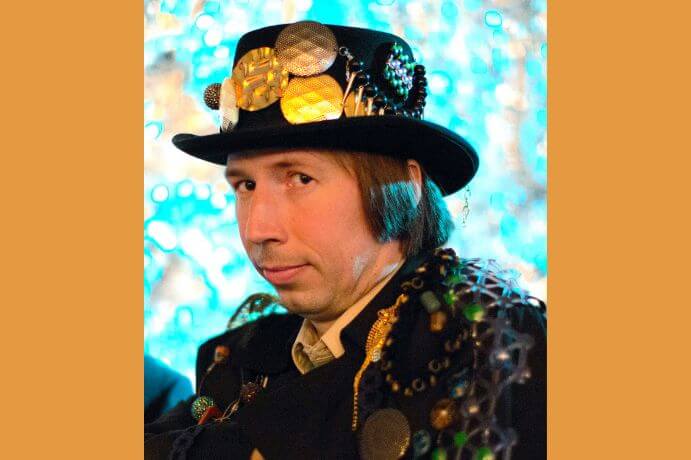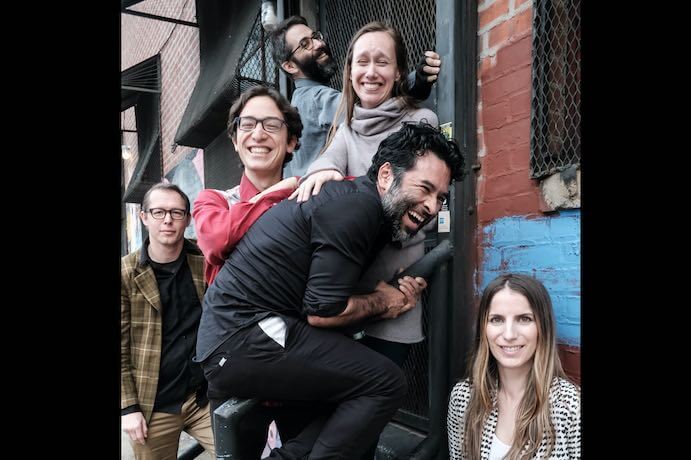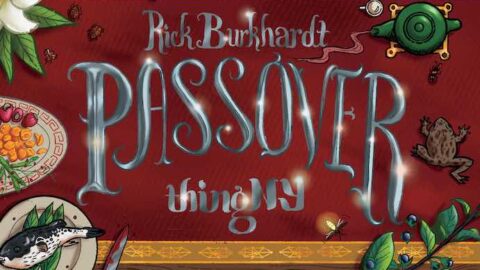For the first time in a decade, Obie Award-winning composer and playwright Rick Burkhardt has released an album. Passover is a work for a sextet of speaking instrumentalists that occupies a dynamic space where linguistics, theater, and music intersect. The work echoes elements of the Jewish festival, which commemorates the story of the Israelites’ exodus from slavery in Egypt.
Burkhardt’s examination of exodus — of moments of departure and the transformation those acts engender — is extraordinary. Commissioned and performed by the joyfully eclectic composer-performer collective thingNY, the album was released on innova Recordings on October 28. For live performances of Passover, members of thingNY (Jeff Young, Dave Ruder, Erin Rogers, Paul Pinto, Andrew Livingston, and Gelsey Bell) sit around a dinner table with a double bass lying across it as they exchange stories with the theme of exodus. Although the album lacks this visual element, the sense of community and proximity remains evident through Burkhardt’s composition.

In Movement I, the narrator tells the story of a man who was given an assignment to write down 100 moments of joy he has experienced over the course of his life. He describes in intricate detail how he grouped each moment into categories such as food, sex, and making music. Feeling nostalgic, he then texts a friend who shared in many of these memories. The friend responds that he just escaped a difficult conversation with his partner. The narrator attempts to cheer him up, and the movement ends.
Although the details of this story are mundane when recounted in prose, Burkhardt’s text setting in the score is quite remarkable. The score for Movement I at first resembles a heavily marked-up draft of an unfinished paper, with X marks floating below various letters in the text and squiggly lines not unlike those used by spell-check. Burkhardt glosses the text not with grammatical corrections, but with percussion notations which interrupt, accompany, and fragment the sound of the words as they are read. The annotations resemble cantillation signs, which dictate the syntax, phonetics, and music of chanted readings from the Hebrew Bible. In a similar way, the percussion notations in this movement facilitate gesture, emphasis, and breaks in the narration.
Movement II is denser, with the full sextet vocalizing and playing. At times, the ensemble imitates or shadows fragments of the narrator’s words with their voices and instruments, intensifying the vocal gestures and emphasizing elements of the text. Throughout the movement, the ensemble asks a maddening series of questions to the narrator, such as “Is that what’s actually happening though?” and “Are those the exact words you used?” The musical texture thins behind these questions, and the narrator often ignores them, suggesting that the questions might be part of his internal dialogue.

Between each text-based movement is an instrumental interlude. With a quiet dissonance, Burkhardt designs spaces for reflection and contemplation, allowing the preceding narrative to breathe. Each subsequent story grows in intensity, as do the stakes of each depicted exodus. This progressive build shows Burkhardt’s mastery of narrative pacing and revelation, which is especially impressive given the innovative and non-linear structure of the work.
By the final narrative chapter of the work, I was on the edge of my seat. What starts as a mundane story about a man working through life subtly escalates into an emotionally charged climax. For the first time, the entire narrative is shadowed by members of the ensemble speaking on pitch while long tones are ominously bowed on the bass. Disjointed story beats from earlier in the work begin to fall into place like puzzle pieces, and a feeling of dread grows until it becomes unbearable — and so I don’t spoil the ending, you’ll have to listen to it yourself to see how (or whether) everything resolves.
Passover is brought to life with exceptional detail and precision by the members of thingNY. The high level of ensemble work is especially apparent in the last movement, where subtle elements of inflection and expression are magnified as if under a microscope. Despite the measured exactness that Burkhardt’s work demands, each narrative feels authentic, immediate, and dramatic. thingNY is no stranger to works that embrace various combinations of music, theater, and language, and with Passover, they show once again that they are masters of the genre.
Passover is a multi-dimensional work that will dazzle enthusiasts of ergodic literature (think House of Leaves by Mark Danielewski or S. by Doug Dorst and J.J. Abrams) and likewise encourages multiple listens to reveal all its secrets. I came away from this album thinking about moments of exodus in my own life, both mundane and remarkable, and their impact on the people in my life. Our departures from conversations, from relationships, from life itself — each exodus sends ripples of change across our communities, and in turn, we are transformed by the departures of others.
I CARE IF YOU LISTEN is an editorially-independent program of the American Composers Forum, and is made possible thanks to generous donor and institutional support. Opinions expressed are solely those of the author and may not represent the views of ICIYL or ACF.
You can support the work of ICIYL with a tax-deductible gift to ACF. For more on ACF, visit the “At ACF” section or composersforum.org.
























